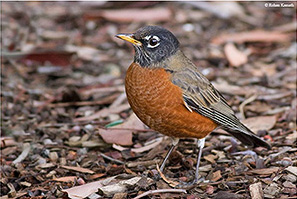 |
American Robin Turdus migratorinus |
|
|
STANFORD LOCATIONS: Common resident throughout campus, nesting in a variety of trees and tall shrubs and on artificial substrates, such as planters and the eaves of buildings. Occasionally seen in flocks from fall through spring. |
 |
Location |
Type |
Mating System |
Parental Care |
2ndary Diet |
Strategy |
|
|
|
|
I: 12-14 DAYS ALTRICIAL |
|
|
|
10 feet - 20 feet (0- 75 feet) |
|
(3-7) MONOG |
F-M |
|
|
| BREEDING: | Habitat generalist: forest, woodland, gardens, parks. 2 broods, occ 3. |
| DISPLAYS: | Courting groups of males chase female, or male struts around female with tail spread, wings shaking, throat inflated. |
| NEST: | Now also buildings, other structures offering sufficient support, also shrubs, occ on ground; unkempt foundation of protruding twigs and grass, cup of mud lined with fine grass. |
| EGGS: | Pale blue, occ white, usu unmarked, occ flecked with brown. 1.1" (28 mm). |
| DIET: | Includes earthworms, snails, etc.; much fruit. Young fed insects. |
| CONSERVATION: | Winters s to Bermuda and Guatemala. Rare cowbird host. Once widely hunted for food. Has expanded range into Great Plains and drier lowlands of w as trees have been planted, structures erected, and irrigation extended, creating suitable nesting sites and moist grassland for foraging. |
| NOTES: | Experiments demonstrate that earthworms are located by sight, not by sound. Adults often belligerently defend nest. Male cares for fledged first brood while female incubates second clutch. Often roost communally when fledged young are strong enough. Poisoning by spraying of DDT for Dutch elm disease in 1950s was instrumental in generating concern over potential "Silent Spring"; DDT-coated elm leaves eventually processed by earthworms, which were then devoured by robins, leading to death or reproductive failure. |
| ESSAYS: | Birds and the Law; Tool Using; DDT and Birds; Mobbing; Bathing and Dusting; Range Expansion. |
| REFERENCES: | Eiserer, 1976; Knupp et al., 1977, Paszkowski, 1982; Wheelwright, 1986. |
| Help | Abbreviations | Species-Alphabetical | Species-Taxonomic | Essays-Alphabetical | |
| Except for Stanford Locations, the material in this species treatment is taken, with permission, from The Birder's Handbook (Paul Ehrlich, David Dobkin, & Darryl Wheye, Simon & Schuster, NY. 1988). | |||||